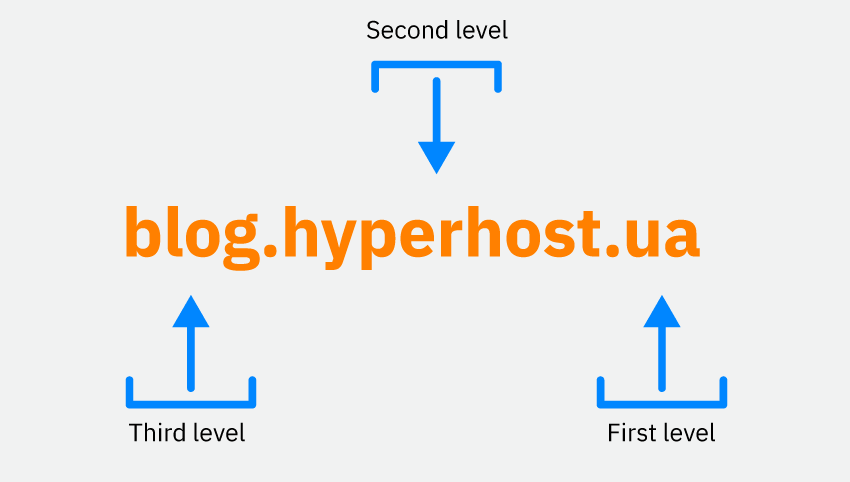What is a Domain?
A domain is a unique name used for identifying a website on the Internet. You choose it yourself and use it after obtaining permission from a domain registrar.
The Significance of Domain Names in SEO
Deciding on the right domain for your site, a name associated with your business, is crucial. It's not enough to merely find a unique option using an online generator. Consider how the domain will impact the future of your website.
The address directly and indirectly influences SEO, determining how visible the site will be in search results and its ability to attract organic traffic. Let's delve into what domain to decide for your website and revisit aspects like the domain zone, name, and others.
Domain Name Basics
A domain name consists of two parts:
- Domain zone.
- Domain name.
Let's discuss this in more detail.

What is a Domain Zone?
A web address consists of multiple hierarchically organized levels. The top-level domain (TLD) is the domain zone, located after the last dot, indicating the category or geographical location of the site, such as “com,” “us,” etc.
What is a Domain Name?
The second-level domain is positioned before the TLD. It is the unique name of the site within the given domain zone. In “exemple.com.us,” “exemple” is the second-level domain.
A subdomain is an additional part used to organize various sections or functions within the main site. An example of a subdomain is “en.wikipedia.org,” where “en” denotes the English version of Wikipedia.
Impact on SEO
So, it's essential to choose a domain name for the site you want to promote and generate income. What should we consider?
How the Domain Zone Affects SEO
Google considers geographical relevance when ranking sites. If a user in America searches for local products or services, sites with the .us domain are prioritized. International addresses like .com or .net might rank lower, as they lack explicit geographical ties and target a broader, international audience. We will revisit the choice of domain zone shortly.
How the Domain Name Affects SEO
In the past, it was popular to include a keyword in the domain. However, recent projects indicate that this strategy is no longer relevant, especially due to the absence of brand traffic.
How You Get Brand Traffic:
- Users familiar with your brand or interested in it enter the company name or related queries into the search bar.
- The search engine recognizes these queries as associated with your site and directs users to it.
Brand traffic is a component of a site's authority. If a site has been around for some time but is not searched or found on the internet for brand-related queries, Google may perceive it as low-quality and unpopular.
What if You Use Keywords in the Domain Name? If the name is non-unique and contains a direct keyword, the user, during a search, will get results from sites promoting the same keyword but with a higher rating.
Choosing and Generating the Right Website Address
Let's draw conclusions on how to choose the right domain name for a website: it should be unique, unlike the names of competitors' sites.
Pay attention to naming; try to come up with a name for the site and, accordingly, a domain name that no one else has thought of before you. Ideally, it should be associated with your business, like “Jeans” for jeans.us. The name is unique and associated with clothes.
Naming is a full-fledged science. It's challenging to come up with it yourself, and delegating it to a specialist is expensive. However, you can arm yourself with free or relatively inexpensive services that suggest name variants for a brand and product, as well as available addresses. For example, Namelix and BrandBucket.
Aspects of Selection
Before deciding a domain for your business, we recommend familiarizing yourself with important nuances.
Length and Abbreviations
Length matters. Consider which domain name is more memorable: Blissify.com or QuantumInnovationHub.com?
It's advisable to choose a domain of up to 15 characters. We strongly advise against resorting to abbreviations like "ukrspecresurs," "dneprukroblspets," and the like. It's better to plan the site name that is convenient for the domain right away.
To better understand how to ensure the reliability and availability of your site in any conditions, be sure to read our article on what a website mirror is.
Types of Domain Zones
Deciding the right zone for your site is an important decision that affects its visibility on the internet and perception by the target audience.
Types of Domain Zones
In the world, there are over 2000 zones, including thematic and geographic ones (associated with specific countries and regions). This classification simplifies user navigation on the internet. For example, domains in the .ua zone denote affiliation with Ukraine, while .store indicates online stores.
Geographic zones are classified into three types:
- National:
- domain.US — a zone for trademarks registered in the USA;
- domain.COM.US — the most popular zone in the USA.
- Regional ones are used to designate regions and cities. In the USA, these include zones like .nyc – New York City’s localized domain extension and .la – Los Angeles Area .
- International ones like .COM, .ORG, .NET, etc., can be used in any country without territorial restrictions. They are the most universal, but it's harder to find a free and unique name in them.
Recently, so-called NewTLDs (new thematic domain zones) have emerged. These are numerous unique and specific options that can better reflect content or business areas. For example, .clothing is ideal for clothing stores, .estate for real estate, and .club for clubs or communities.
Cost of Domains
The cost of a domain can be influenced by the choice of the domain.
National addresses are usually cheaper, while international ones like .com or .net are pricier.
NewTLDs are even pricier, but can effectively reflect the specificity and uniqueness of the business. For example, the “shop” zone is specifically created for online shopping.
It's also worth noting that popular names in any zone may cost more due to high demand. The choice should be made based on a balance between cost and alignment with the business strategy.
Additionally, many hosting providers offer free registration for a year as a bonus when purchasing hosting or renting a server. This is probably the only way not to pay for a domain for some time without risks.
Challenges of Occupied Domains
If a company has a unique, distinctive name, finding an available domain is usually not difficult. You can check availability on any registrar's website.
What to Do If a Domain is Taken
If suitable options are already taken by competitors, there are several strategies:
- Contact the owner of the occupied domain and try to purchase it.
- Monitor the domain and try to intercept its renewal.
- Choose another domain zone.
However, it's better to come up with a unique variant initially – it is the most promising and doesn't require additional costs.
History of Previous Registrations
Guidance on how to decide a domain would be incomplete without an important rule: always check the history. If the desired address is free, it doesn't mean you'll be the first owner. The domain may have belonged to a site with a bad reputation, which can negatively impact SEO. Promotion after re-registration may be challenging due to search engine sanctions, requiring significant efforts to restore status. However, if the name had a good reputation and links from other sources, it could simplify promotion, especially if the new site's theme aligns with the previous one.
Legal and Technical Aspects
When deciding on a domain name, ensure it doesn't violate copyrights or infringe on someone else's trademark. Violating these rights can lead to legal problems, including demands for domain transfer or removal. It's also recommended to register in multiple domain zones to prevent use by competitors or squatters.
Purpose of Subdomains
A subdomain is not a mandatory element and is used to define sections of a site. For example, in the address forum.ukr.net, the word “forum” is a subdomain. Search engines perceive it as a separate site, allowing for separate marketing campaigns, such as promoting a blog independently of the main site.
Practical Tips on Choosing a Web Address
When considering how to choose a domain name, nuances of writing and pronunciation should be considered.
Recommendations:
- Avoid letters with multiple Latin spellings.
- Do not mix words from different languages – this complicates perception and memorization.
- Avoid using hyphens and numbers in the name unless they are part of the brand or project name.
- Consider the age of the target audience. If the site is not exclusively for young people, avoid using modern slang.
- Most importantly: avoid key phrases.
Domain Registration and Verification
Anyone can acquire a domain name by visiting a registrar's website, selecting an available name, and paying an annual fee for its use. Typically, the registration is for one year with the option to renew. If the renewal payment is not made on time, the domain first gets "frozen" and then returns to the public space, available for registration by other users.
How to Check Domain Availability
Before choosing a domain and domain name, it needs to be checked. On any registrar's website, you can enter the desired domain name to find out if it's occupied or available. This process allows seeing alternative options and available domain zones.
Checking Domain History
To learn a domain's history, use two main tools:
- WHOIS: This service shows information about domain owners, registration and expiration dates, and the servers hosting the site. If owner details are hidden, WHOIS provides the registrar's contacts.
- Web Archive (web.archive.org): This resource allows view historical versions of web pages, showing how the site's design, structure, and content changed over time.
These services provide valuable information for understanding past activity and changes associated with a specific domain name.
Find out about the importance of checking the domain against search engine filters to ensure that your domain choice doesn't impact your site's visibility and accessibility online by reading our in-depth article on this topic.
How to Register a Domain
To register, enter personal details: for individuals, provide full name; for legal entities, the company name and address. It's crucial to provide real data – these details will help confirm ownership rights in case of problems. Furthermore, using the primary email address is critical as it will receive all notifications, including login information.
Conclusion from M.System Experts
Choosing a domain name for a site is a “star-marked” task. The simplest and safest solution is to use a unique brand name as the address. It should be one of a kind, avoiding phonetic similarity with competitor sites. Avoid using key phrases in the name.
- A unique name will be memorable to users.
- The chance of users being directed to competitor sites via domain search decreases.
You gain brand traffic; more people search for your unique brand, leading to increased trust from search engines.
Choose the domain zone based on geography and activity:
- com.us is suitable for US commercial organizations.
- com is recommended for businesses targeting the international market.
- For companies operating in specific regions, such as NY or LA, it's better to choose a sub-regional domain like .ny and .la.
When thinking about which domain to decide, remember: it should be short, readable, and memorable. Preferably, avoid numbers and hyphens. Before registering a domain, check its history. You can buy a “ready-made” domain name with a rich history and backlinks – this will be a strong start for site promotion. However, it's crucial to ensure that the domain has no “skeletons in the closet.” This task can be accurately performed only by an SEO specialist, so we recommend involving one in the project development stage.
